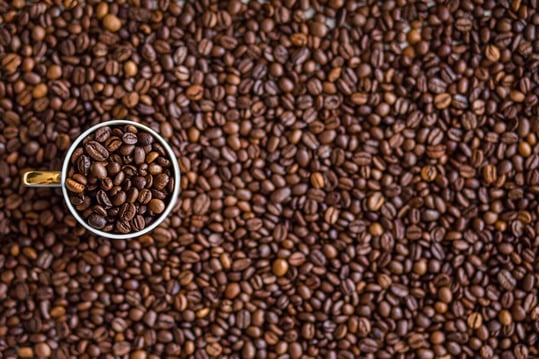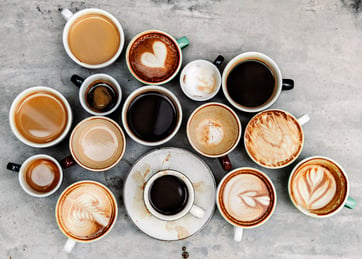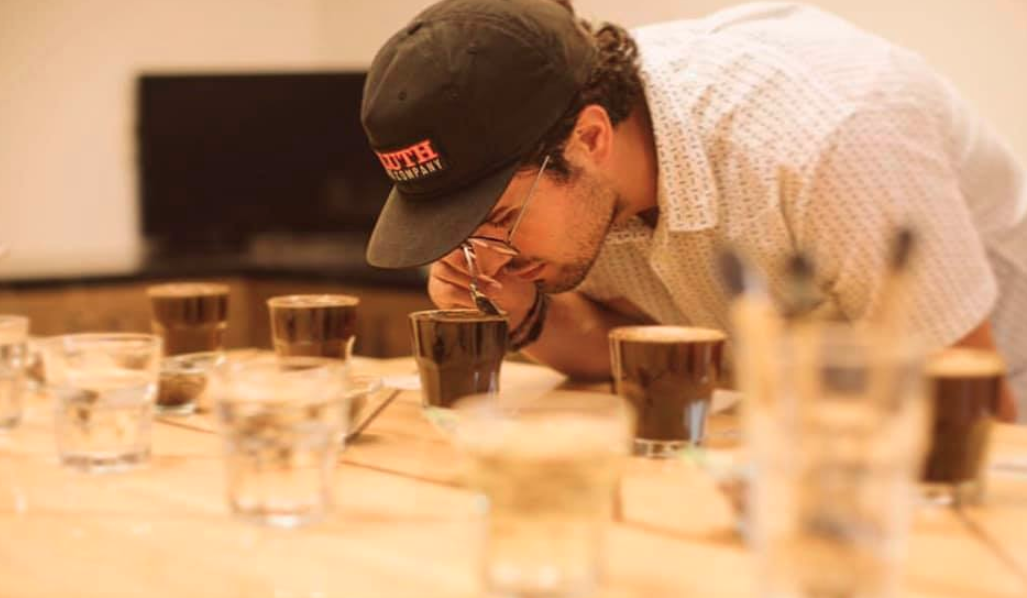Why are different coffee beans so distinct?
Before that rich, savory coffee wakes you up in the morning, it begins as green, almost odorless beans. It’s the roasting process that transforms the beans into that magic elixir you love. The degree of roast has a direct effect on the taste and level of caffeine in your favorite java, and so do the type of beans you’re drinking.
The four types of beans
Have you ever heard of the "Coffee Belt"? It’s a global region that follows the equator, where all of the world’s coffees originate. The beans thrive in those hot environments, and each region offers unique conditions that appeal to four different bean categories.

1. Arabica
If you drank coffee today, there’s a better-than-fifty-percent chance you consumed Arabica beans. That’s because they’re the most-used bean, comprising approximately 60% of the world’s total coffee consumption. Not surprisingly, Arabicas are very high-quality beans, and can command relatively higher prices.
Most Arabica beans grow in the Latin American countries that stretch through the Coffee Belt. However, one Arabica is not exactly like another. Different regions with different climates yield beans with unique flavor profiles. Most tend to be nutty and chocolatey, while others can have fruity, spicy, or earthy tones. One thing all Arabicas share, however, is that they have more acidity compared to other bean types.
2. Robusta
Coming in second place for overall consumption is the Robusta bean. They’re immensely popular because they’re packed with energizing caffeine. In fact, Robusta beans typically contain twice the caffeine as their Arabica counterparts. They also look different than Arabicas. Instead of the classic almond shape we usually picture when thinking of coffee beans, Robustas look more like little balls.
Robusta beans only grow in the Eastern Hemisphere, mainly in Indonesia and Africa, and flourish quite well in either high or low altitudes. The beans, once roasted, have a very deep flavor that some drinkers describe as bitter or harsh, but it’s that very character that makes Robusta perfect for espresso shots. Robusta beans also maintain their distinct flavor when combined with creams and sugars, versus getting overpowered by the added flavors.
3. Liberica
To tour a Liberica bean farm, there’s only one place to go: The Philippines. It’s the only region in the world where Liberica grows. Serious coffee enthusiasts applaud the beans for their fruity and very floral aroma. On the tastebuds, a hot cup of Liberica coffee boasts a full body with woody and smoky tones. However, drinkers caution that a good cup is the product of thoughtful roasting and brewing. Poor preparation can result in flavors that aren’t desirable. Liberica beans account for only 2% of global consumption, and can be hard to find in the U.S. They're sold mostly across Asia and in some South American countries, where Liberica ranks as a lower-priced brew that shows up in many of the instant coffees of those regions.
4. Excelsa
Excelsa beans are similar to Liberica coffee beans. In fact, Excelsa was named as a genus of Liberica because both types grow on large, 20+ foot tall trees at the same altitudes and have similar almond-like shapes.
Many roasters use Excelsa in blends to give the finished coffee some complexity and an extra boost of flavor. Drinkers describe the Excelsa varietal as having a tart, fruity body with notes that are both roasty and lingering. You’ll find Excelsa beans growing mostly in Southeast Asia where they account for about 7% of the world’s coffee consumption. If you can get your hands on some roasted Excelsa or Liberica beans, give them a try and see what you think.
Blend 'Em all together
Blended bags of coffee typically have beans from two or more countries and different regions. Sometimes, they can be even more complex, but most roasters routinely use about four varietals in a blend. Roasters must then determine the percentages of each bean type, since that dramatically changes the final flavor. Just like cooking, it’s all about the recipe that sets a blend apart.
Roasting, explained
 It’s funny to watch consumers gravitate to dark-roast coffee when they want a serious jolt of caffeine. Did you know that light roast beans actually pack the biggest caffeine wallop? That’s because beans actually deplete their caffeine when they’re roasted longer and at higher temperatures.
It’s funny to watch consumers gravitate to dark-roast coffee when they want a serious jolt of caffeine. Did you know that light roast beans actually pack the biggest caffeine wallop? That’s because beans actually deplete their caffeine when they’re roasted longer and at higher temperatures.
In addition to caffeine level, the length of roast time also affects how acidic the coffee is, and how much body and flavor intensity it has. During roasting, the beans absorb heat which darkens their color. At higher temperatures, oils appear on the bean surface. At 401°F, the beans crack for the first time and start to expand. Around 437°F, they crack a second time. Coffee beans are never roasted above 482°F because they will start to thin and take on a burnt taste. Which roast is right for you?
1. Light
Light roasts are roasted for the least amount of time and typically reach an internal temperature of 356-401°F after the first crack occurs. Light roasts have the most caffeine and the most acidity. It’s easiest to taste the origin flavors in light roasts since the roasting is completed before additional heat unlocks other flavors from within the beans. The acidity in light roasts is often accompanied by citrus tones that many coffee drinkers find tasty.
2. Medium
Medium-roasted coffee reaches internal temperatures of 410-428°F after the first crack appears and just before the second one occurs. Medium roast has more body, less acidity and more balanced flavors than a light roast. This makes them the most popular choice among American coffee drinkers – under names such as House Blend, Breakfast Roast, and American Roast.
3. Dark
The roasting temperature for a dark roast is between 464-482°F. There are visible oils on dark roast beans, which contributes to making them the richest, most full-bodied and least acidic coffees. Dark roasts have sweeter flavors because the sugars in the beans have had time to caramelize. The downside (or upside, depending on your preference), is that dark roasts have the least amount of caffeine because they’re roasted the longest.
A local roast in Duluth Coffee Company
 Duluth, Minn., is home to some spectacular roasting.
Duluth, Minn., is home to some spectacular roasting.
Sam Levar is the Sales Manager at The Duluth Coffee Company. The brand selects green beans from specific farms and regions around the world. Each coffee is then roasted with insightful techniques that bring out the nuances of every bean. Duluth Coffee is delivered fresh for enjoyment at its peak. I asked Sam about Duluth Coffee Company's roasting philosophy.
"As a roaster, we partake in the final drying process of the coffee seed (bean). Our coffee is meticulously picked, sorted, dried, and processed by producers throughout the world. Our goal is to roast each coffee to highlight the potential of the complex flavors within each lot. Roast profiles are selected based on the qualities from each individual origin. Our profiles are on the lighter end of the spectrum, as we aim to bring out the natural sweetness. Dark, oily coffee often carbonizes sweet coffee characteristics, making a bitter beverage."
He continued, "Coffee origins play a large role in the flavor profile of the beans. The origin where coffee is grown will often determine what varieties of coffee seeds are planted as well as how the coffee is dried and processed. All of these factors influence flavor profiles and are unique to each origin. As origins, producers and mills have more access to information. Coffee cultivation and processing becomes more dialed in, making complex flavors. This is why we strive to have relationships in origin. Our relationships are far more than just an exchange. We work with Cafe Imports (based out of the Minneapolis area) to connect with exports and producers in origin."
I asked Sam to expound on the topic of coffee strength and characteristics. He chuckled. "Coffee strength is a lengthy topic, as most consumers have different interpretations of strength. Some consumers are referring to caffeine content and some are referring to flavor profiles. Ultimately, the industry interprets it as extraction. Extraction is the process of brewing at a specific weight ratio. We recommend a 1:16 ratio, meaning for every 1 gram of coffee, you’ll be brewing with 16 grams of water. This computes to about 4 ounces of coffee to a half gallon brew. Coffee that is brewed with large ratio will yield in a weaker, more diluted coffee."
Duluth Coffee Company Specialty Beverages
Sam continued, "There are many variables at play with caffeine content due to the complexities of extraction, not roast. There is very little difference in caffeine content if the same coffee is roasted at different profiles, but brewed identically. If consumers are looking for a highly caffeinated beverage, lead them towards cold brew coffee. The length of the cold brew extractions ends up pulling out more caffeine than what would be present in a hot brew.
Coffee is one of the world's most complex beverages. Consumers are starting to understand that coffee doesn’t need to be flavored, rather, it needs to be roasted to a profile that brings out the inherent qualities of its bean type. We provide flavor notes for our coffees, but they are natural flavors found within the coffee, not additives.
All roast levels can be used in any brewing method. Typically, Duluth Coffee Company recommends specific origins instead of specific roasts. Sam outlined it for me:
- Espresso: Espresso’s roots are from Italy, where coffee was roasted very dark, and used in an espresso machine for a quick shot of coffee (2oz). Today, espresso drinks are wildly different than the traditional Italian beverages. Our espresso blend is a darker roast, but still offers a lot of sweetness and balance.
- Lattes: Most beverages are large, flavored, milk-based drinks with a few shots of espresso for caffeine. Specialty coffee menus are typically more traditional, offering an 8oz cappuccino, 4oz cortado, and 12oz latte which all consist of espresso and steamed/frothed milk.
- Pour Over: Most lighter roasts work best in pour overs. For a single cup, at home, with your pour over, we recommend an Ethiopian or Costa Rican coffee. These are bright and floral.
- Drip: Any origin or roast level works great in a traditional drip brewer. We sell a majority of Papua New Guinea, Guatemala, and Colombian roasts.
- Iced Coffee: When cold coffee was first introduced, many people were brewing hot coffee and pouring it over ice. This extraction creates a very acidic, sour tasting beverage. So from the early concepts of iced coffee came ...
- Cold Brew: The process of cold steeping ground coffee in water for 12+ hours. Our cold brew is cold steeped for 20 hours to make a concentrate. This extraction creates a highly caffeinated, full-bodied beverage without the bitterness found in a hot brew. Our flagship cold brew is Colombian coffee from the region of Huila. It offers a chocolatey flavor with a rich body.

"Coffee processing is the method used to remove coffee cherries and dry beans. Most coffee is wash-processed, which means the coffee cherries are removed from the beans and washed in water before being dried. Other processes such as natural-process leave the cherry on the beans to be fermented while being dried.
While most certifications have been developed to hold consumer goods to a standard, they often have their shortfalls. The industry is losing confidence. Fair Trade Certifications were created as a minimum wage for sustainable farming, but they fail to encourage the progress of coffee quality and pricing. Organic certifications are costly to small farms and require many resources. Many other buzzwords are used in the coffee industry. We’ve learned that certifications are often substitutes for relationships."
Speaking of relationships, I asked Sam what DCC's biggest seller is in terms of bulk beans in store and through distribution. His answer is very ... artisanal. He said, "Relationships! We travel to origin multiple times a year to connect with coffee producers. We know where our coffee comes from, and the care and handling of the product. We have access to some of the world’s best coffee, and continue to buy specialty coffees far above the fair-trade prices. Our mission is to source, roast, and brew coffee with integrity and intentionality."
I love that answer and I wholeheartedly am delighted with the entire brand and relationship our two companies have.
If you have any questions about which coffees are ideal for your business or break room, contact Bernick’s and we can talk about our coffee programs and all the brands we represent. Now, I think I’m going to put on a fresh pot.


